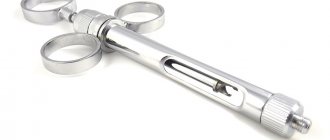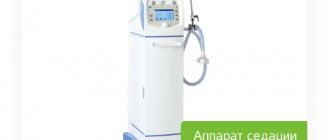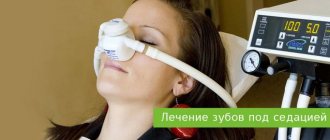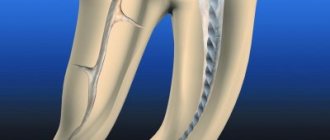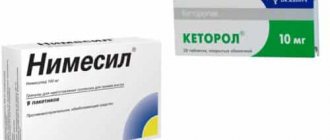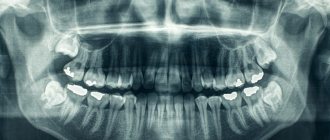Conduction anesthesia is considered the most effective method of pain relief in dental practice. The essence is to block nerve impulses that are directly responsible for pain syndromes in the brain.
After the administration of the anesthetic, the pain threshold is reduced to zero. This allows the necessary operation to be carried out smoothly. The advantages of this method are good tolerability and high efficiency. In addition, after the intervention, the pain syndrome continues to remain at a minimal level.
Features and principle of action of conduction anesthesia
Conduction anesthesia is a local anesthesia and involves the introduction of a drug into the peripheral region of the nerve that ensures the functioning of this part of the body. Dentists in most cases use conduction anesthesia to treat teeth located in the lower jaw.
The technique is aimed at blocking impulses transmitted from nerves to the brain. As soon as the drug enters the nerve, sensitivity is reduced to a minimum level. The duration of action of the anesthetic depends on the substance used.
A number of features of conduction anesthesia can be distinguished:
- The injection is carried out with drugs, the concentration of which reaches 2%. Compared to other methods of pain relief, the content of active substances is at a high level.
- Loss of sensitivity does not occur at the site of drug administration, but in the nerve that is located in this area of the body.
- Conduction anesthesia has a minimal number of complications and side effects.
- The method allows you to control the duration of pain relief and the area of effect of the drug.
Types of torus anesthesia in dentistry
There are two main techniques for performing this type of anesthesia:
- According to Vazirani-Akinosi
- According to Go-Gates
The Vazirani-Akinosi technique is used only if all other methods of pain relief have already been tried and have not sufficiently relieved sensitivity.
The advantage of Vazirani-Akinosi is effective pain relief in the case of the presence of more than 3 nerves in the tooth, but the disadvantages include the complex method of implementation.
The Go-Gates method is more common, although it is also not so easy to use.
Indications for conduction anesthesia
- Implantation.
- Carrying out surgical intervention (removal of cysts, granulomas, ulcers and benign neoplasms).
- Therapy of dental diseases.
- Preparation before surgery.
- Removal of teeth or roots.
- Inflammation in the oral cavity.
- Carrying out preventive procedures to prevent periodontal diseases and caries.
- Inability to use general anesthesia.
Features of carpule anesthesia
Injection anesthesia in modern clinics is performed using the carpule method - using a special syringe into which a capsule with medicine is already inserted. The advantages of carpule anesthesia are obvious:
- Thin needle. In carpule syringes, the thickness of the needle does not exceed 0.3 mm (for comparison, the thinnest needles of disposable syringes are 0.6 mm thick).
- Absolute sterility. The syringe into which the anesthetic cartridge is inserted is packaged by the manufacturer. There is no need to perform any additional procedures before administering the medicine.
- To ensure a prolonged effect of anesthesia, adrenaline is added to some carpule formulations.
Contraindications to conduction anesthesia
- Poor blood clotting. This feature can lead to bleeding.
- Allergy to used painkillers.
- Disorders of the cardiovascular system (arrhythmia, ischemia, tachycardia, heart valve defects, etc.). These pathologies are not compatible with adrenaline, which can be used to constrict blood vessels.
- The presence of inflammation or ulcers at the injection sites of the anesthetic drug.
- Open wounds, infectious inflammations and contaminated wound surfaces on the patient’s extremities.
- Childhood.
- Mental disorders, unstable psycho-emotional background of the patient.
- Patient refusal to use this type of anesthesia.
Contraindications and side effects
Contraindications to dental anesthesia are:
- Allergic reactions to substances included in anesthetics;
- History of cardiovascular diseases;
- Diabetes;
- Pathology of the endocrine system organs;
- Some types of severe injuries of the maxillofacial area.
Side effects of anesthesia in dentistry
Whether the doctor is a professional in his field, complications with local anesthesia in dentistry are very unlikely. There are some things that worry patients after dental treatment and, in principle, are a variant of the norm: swelling of the lip or swelling of the cheek, pain in the gums or even a headache for several hours.
However, all these symptoms should go away within 1-3 days after treatment. If you see that the situation is not improving or even worsening, contact the dentist who performed the procedure.
Methods of administering conduction anesthesia
Methods of administering conduction anesthesia can be divided into 2 groups:
- Extraoral. Used in the presence of inflammatory foci in the oral cavity. These include:
- Submandibular. The pain medication blocks the inferior alveolar nerve.
- Podzykulova. The drug is injected under the edge of the cheekbone arch.
- Mandibular. The mandibular foramen loses sensitivity.
Once the anesthetic is injected into the treated area, the numbing effect occurs within 15 minutes. The duration of the anesthetic effect depends on the type of medication used.
- Intraoral. These include:
- Apodactylous. The alveolar nerve is blocked.
- Torusal. The anesthetic is injected into the mandibular ridge. Molars and premolars lose sensitivity.
- Tuberal. Anesthesia is injected into the area of the molars located on the upper jaw.
- Infraorbital. It is used to block sensitivity in the anterior wall of the maxillary bone, mucous membrane and alveolar process.
- Palatine. The palate and alveolar process are anesthetized.
- Incisive. The anesthetic is injected between the upper canine and incisor. The hard palate, nasopalatine nerve and soft tissues surrounding the tooth become numb.
When administered intraorally, the effect occurs 10 minutes after injection.
Preparation for conduction anesthesia
Before performing the operation under general anesthesia, it is necessary to undergo a standard examination. During diagnosis, special attention should be paid to the patient’s neurological condition, his psyche and behavior.
Before the procedure, the specialist will explain in simple, accessible words about the sequence and method of administering anesthesia, as well as the sensations that may accompany the patient during pain relief. In addition, the doctor will definitely check the patient’s reaction to the anesthetic drug to make sure there is no allergic reaction.
The anesthesiologist must follow the rules when administering conduction anesthesia:
- First of all, it is necessary to numb the skin using a gentle method.
- The needle must be fixed in a strictly defined place in order for the anesthetic to reach the desired area.
- Paresthesia must be present. It indicates that pain relief was carried out correctly and sensitivity has decreased.
- Drugs should be administered in portions with aspiration samples to prevent them from entering the bloodstream.
- During anesthesia, it is necessary to continuously monitor the patient's blood pressure and pulse.
- The room in which the procedure is performed must be equipped with all the necessary instruments for pain relief, as well as means of resuscitation and treatment of possible complications.
Stages of administration of conduction anesthesia
- A consultative appointment, during which a specialist determines the presence of chronic diseases and evaluates test results that may become contraindications to pain relief.
- Detection of nerve endings that need to be anesthetized.
- Disinfection of the skin puncture area with a special solution.
- Injection of anesthetic into certain areas. At the same time, the rate of administration of the anesthetic is observed and the volume of the injected substance is controlled.
- Monitoring the patient after pain relief.
- Before the start of surgery, the patient is asked control questions to determine the level of sensitivity.
The duration of the analgesic effect depends on the drug used and its dosage. Modern painkillers retain their effect for up to 40-60 minutes.
What you need to know about anesthesia for dental treatment
10-30% of people do not go to the dentist because of pain. Delaying treatment makes the problem worse. Pain management helps patients feel comfortable during dental procedures.
Types of dental anesthetics
Anesthesia means absence or loss of sensation. With light anesthesia, the person is conscious. In severe cases, the patient is put to sleep. The doctor at the Nika Dentistry clinic uses medications separately or in combination. Selects medications for a safe procedure. The type of anesthetic used also depends on the person's age, health, length of the procedure, and previous negative reactions to anesthetics.
Short-term medications are applied directly to the tooth area. Long-acting is used when complex jaw surgery is performed.
The success of dental anesthesia depends on:
- drug;
- areas of anesthesia administration;
- type of procedure;
- time of the operation;
- severity of inflammation.
Local anesthesia in the lower jaw is not as strong as in the upper jaw.
Doctors give three types of anesthesia: local, sedative and general. The choice depends on the location of the manipulation, the severity of the problem and the combination with other medications.
Local anesthesia
Local anesthesia is used for simple procedures such as tooth filling, which require a short time to complete and are less complex. The person is conscious and talking when local anesthesia is given. The area is numb so that the patient does not feel pain. A popular local anesthetic is lidocaine.
Local anesthetics will numb the pain within 10 minutes, and the best anesthesia for dental treatment wears off between 30 and 60 minutes. Sometimes a vasopressor such as epinephrine is added to enhance the effect and prevent the anesthetic effect from spreading to other parts of the body.
Local anesthetics are available in the form of gel, ointment, cream, spray, patch, liquid and ampoules. Use topically (apply directly to the area to numb it) or inject into the area being treated.
Sometimes sedatives are added to anesthetics to help you relax. The patient remains fully conscious and responds to commands after slight sedation. If the drug is moderate, the person is semi-conscious or almost unconscious if the sedation is deep.
Sedatives are administered orally (tablet or liquid), inhaler, intramuscularly, or intravenously. During moderate to deep sedation, the doctor monitors your heart rate, blood pressure, and breathing.
General anesthesia
General anesthesia is used for long procedures or when the client is nervous and interferes with treatment. The person is unconscious, does not feel pain, the muscles are relaxed, and does not remember how the operation took place. The medicine is administered by putting a mask on the face or intravenously. The dose depends on the procedure and the patient's condition.
What are the side effects
The side effects of dental anesthesia depend on the type of anesthetic used. General anesthesia has more risks than local anesthesia. Reactions also vary:
- nausea or vomiting;
- headache;
- sweating or shaking;
- hallucinations, delusions, or confusion;
- slurred speech;
- dry mouth or throat;
- pain at the injection site;
- dizziness;
- fatigue;
- numbness;
- trismus caused by trauma from surgery.
Vasoconstrictors such as epinephrine added to anesthetics also cause heart and blood pressure problems. These are some side effects of anesthetics. Ask your dentist about the medicine and any problems that may arise after use.
Precautions when prescribing
A person gives consent to treatment before sitting in the dentist's chair. Ask your doctor questions about the risks and precautions to take for a positive outcome.
Pregnancy
The dentist or surgeon will discuss the risks and benefits of anesthetics for the expectant mother and fetus.
Special Needs
For children and people with special needs, the type and dose of anesthetic is adjusted to avoid adverse reactions or overdose.
Aged people
Seniors with health problems will require dosage adjustments and monitoring during and after surgery. Some people become delirious or experience confusion and memory problems after surgery.
Liver, kidney, lung, or heart problems
People with liver, kidney, lung, or heart disease require a dose adjustment because the medicine will take longer to leave the body or will have a strong effect.
Neurological diseases
If you have a history of stroke, Alzheimer's disease, Parkinson's disease, thyroid disease or mental illness, the risk of general anesthesia is increased.
Other conditions
Tell your dentist if you have a hiatal hernia, acid reflux, infections or open sores in your mouth, allergies, severe nausea and vomiting, or are taking medications that cause drowsiness.
The risks are higher for those who:
- sleep apnea;
- epilepsy;
- obesity;
- hypertension;
- heart problems;
- attention or behavior disorder;
- chronic obstructive pulmonary disease;
- gastric bypass;
- Substance abuse.
What are the risks of dental anesthesia
Most people do not experience adverse reactions with local anesthesia. There is a higher risk with general anesthesia, especially in older people and people with medical complications. There is an increased risk of abnormal bleeding while taking blood thinning medications such as aspirin. If you are taking painkillers or nerve medications, tell your dentist or surgeon so they can select an anesthetic.
Anesthesia risks:
- seizures;
- coma;
- respiratory arrest;
- heart failure;
- heart attack;
- stroke;
- hypotension;
- hyperthermia;
- muscle stiffness;
- breathing problems;
- tachycardia.
Allergic reaction
Tell your dentist about any allergies, including reactions to dyes or other substances: rash, itching, swelling of the tongue, lips, mouth, or throat, and difficulty breathing; The anesthetics articaine and prilocaine at a concentration of 4% damage nerves and cause paresthesia;
Conclusion
Discuss concerns about the procedure with your dentist. Ask questions about medications used for pain and what to expect during and after treatment. Get a medical history from your physician, including information about allergies and other medications you take, including over-the-counter and prescription medications and dietary supplements.
Ask for instructions on how to behave before and after, including eating and drinking before and after oral procedures. Ask if transportation home needs to be arranged and see if all questions have been asked of the dentist. The dentist will provide instructions to follow before and after the procedure, and will provide a phone number to contact them in case of complications or questions.
Drugs used
The success of conduction anesthesia depends not only on the technique used, but also on the drugs used. The following medications are used for this pain relief technique:
- Solutions of the Articaine series. They have a long lifespan and high efficiency. These include:
- Ultracaine.
- Septanest.
- Ubistezin.
- Lidocaine. It is a highly effective anesthetic and at the same time contains a minimal amount of toxic substances.
- Melivacaine. The duration of action of this drug is about 40 minutes. Melivacaine has no contraindications for use.
- Novocaine. This is perhaps the most frequently used remedy. It is characterized by low toxicity and rapid hydrolysis in the body.
Local complications and errors during the anesthesia procedure
Before any surgical intervention in the maxillofacial region, it is necessary to carry out complete tissue analgesia, since anesthesia in dentistry is not only a humane attitude towards the patient, but also a method of pathogenetic therapy, which is used in the treatment of any inflammatory process and diseases of a traumatic nature that develop in shock zone.
The doctor cannot expect that the disease will proceed without complications if he performed the intervention without providing complete anesthesia in the area of injury or inflammation.
Inadequate pain relief is one of the most common mistakes made by clinic doctors when treating patients in all areas of their specialty.
Another common mistake doctors make is administering the anesthetic too quickly. Under no circumstances should it be allowed during infiltration anesthesia of soft tissues. The anesthetic is injected under high pressure, so a depot of anesthetic solution, which is necessary for tissue infiltration near the needle tip, is not formed. Instead, the solution is shot into the depths in the form of a jet and disperses. The desired analgesic effect is not achieved.
When introducing an anesthetic into the bone, for example, when performing intraligamentary anesthesia, the desired effect is achieved precisely when the drug is administered under high pressure. However, even in this case, it must be taken into account that too rapid administration of the drug can cause rupture of the periodontal ligaments of the tooth and its displacement from the socket.
Another type of complication is damage to the vessel by the injection needle and the formation of a hematoma. This complication is common with intraoral “tuberal” anesthesia. In rare cases, it occurs during anesthesia of the infraorbital nerve. Taking into account the fact that anesthesia of the area near the tubercle of the upper jaw almost always leads to the formation of a hematoma, and its suppuration leads to the formation of phlegmon of the pterygopalatine fossa and infratemporal space, which seriously threatens the patient’s health, it is necessary to abandon the use of this method of anesthesia. In addition, infiltration anesthesia using modern means ensures the achievement of the desired anesthetic effect for any type of dental intervention in the area of the anatomical structures of the upper jaw.
In order to prevent the occurrence of a hematoma during anesthesia at the lower orbital foramen, it is necessary to advance the needle in the direction of distribution of the solution. You should not insert a needle into the canal, since modern anesthetics have diffusion capabilities that allow the injected drug to quickly spread and block the nerve trunk. If there is a suspicion of the development of a hematoma, then it is necessary to clamp the area of tissue with a tampon for several minutes. After the analgesic effect is achieved, the planned intervention can begin. You can also use hypothermia, and after three days - resorption therapy.
A rare, but more serious complication is the breaking off of an injection needle. Most often this happens if the anesthesiologist makes too sudden a movement when the syringe needle is already in the muscle tissue. The risk of complications increases if the needle is completely immersed in the tissue. In order to avoid complications, it is necessary to control the quality of the needles used for injections, as well as the extent to which the doctor adheres to the rules of anesthesia. Do not allow the needle to be completely immersed in the tissue or make sudden movements with the injector. If the needle does break off, it can be removed on an outpatient basis only if the end is visible above the surface. If tissue dissection is necessary to remove a broken needle, the patient must be hospitalized. An X-ray examination must be done before surgery. X-rays should also be taken at the stage of the operation, the volume of which can be significant.
Damage to the nerve trunk by an injection needle is relatively common, resulting in the development of traumatic neuritis, which is accompanied by paresthesia or severe pain. To prevent this from happening, the needle must be advanced in the direction of the anesthetic flow. If paresthesia or pain appears, it can last from 3 days to a week and even up to several months. In this case, taking B vitamins and analgesics, as well as physiotherapeutic procedures, are indicated.
If the fibers of the internal pterygoid muscle are damaged by an injection needle, its contracture may develop and the function of the lower jaw may be impaired. In order to prevent complications from developing during anesthesia of the inferior alveolar nerve, you must carefully follow the technique of advancing the needle to the bone of the inner surface of the jaw branch to the mandibular foramen. Most often, contracture can be eliminated within a few days using physical therapy and painkillers. If its course is prolonged, then mechanotherapy should be performed. Even more severe damage to the nerve trunk or muscle fibers can occur when the tip of the injection needle is bent; for this reason, syringes with a deformed needle should not be used.
Post-injection pain and swelling can occur due to trauma to the periosteum, or as a result of too intense injection of anesthetic into the soft tissue. Another cause of complications lies in the use of expired painkillers. Prevention of such complications comes down to compliance with the rules of anesthesia. It is necessary to exclude subperiosteal and too intense injection of an anesthetic solution into the tissue, as well as the use of anesthetics that have been certified and have not expired.
Treatment of complications is reduced to physiotherapeutic procedures. It is also recommended to use painkillers and antiallergic drugs, such as diphenhydramine and suprastin.
Paresis of facial muscles develops as a result of blocking the branches of the facial nerve with an anesthetic drug. This can be observed during extraoral anesthesia on the maxillary tubercle and during anesthesia of the inferior alveolar nerve. The paresis of individual facial muscles that develops as a result goes away after the painkiller wears off and does not require treatment.
The development of diplopia (double vision) is possible when the anesthetic solution spreads into the infraorbital canal with appropriate anesthesia, resulting in paresis of the extraocular muscles. This complication goes away on its own after the effect of the anesthetic wears off.
The most serious complication that threatens the health and even the life of the patient is tissue necrosis; it develops as a result of the introduction of a non-isotonic solution by mistake. This could be alcohol, calcium chloride, gasoline, or some other drug. The first sign of necrosis is severe pain that occurs at the beginning of solution administration. It is necessary to immediately stop administering the drug, infiltrate the tissues with a diluted anesthetic and, if possible, cut the tissues wide to allow intensive drainage. If a non-isotonic solution was injected into deep tissues, then after first aid the patient should be immediately hospitalized. This is necessary because severe tissue swelling may soon develop, possibly spreading to the neck, causing difficulty breathing and requiring emergency resuscitation.
When observing patients who were mistakenly injected with aggressive liquids during anesthesia, in one of the patients, due to the administration of a non-isotonic solution near the mandibular foramen, necrosis of the pterygomaxillary, perimaxillary space and the lateral surface of the neck began to rapidly develop. On the eleventh day, bleeding appeared, which is why the external carotid artery had to be ligated. Another patient was mistakenly injected with alcohol into the pterygomaxillary space, which resulted in persistent contracture of the lower jaw and extensive tissue scarring. This required extensive surgical intervention. The erroneous administration of 2 ml of a vasoconstrictor drug to a teenager ended tragically.
For preventive purposes, to avoid such complications, carpule technology is used. This eliminates errors when selecting an anesthetic drug.
Advantages and disadvantages of conduction anesthesia
Advantages:
- The drug can be administered outside the surgical site.
- Anesthesia has a long-lasting effect. A specialist can monitor the duration of action of the medication.
- To achieve the desired effect, small doses of painkillers are sufficient.
- There is no deformation of soft tissues in the operated area.
- When exposed to conduction anesthesia, salivary activity decreases.
- The technique is safe, so it can be used from the age of 12, and also in some cases in pregnant and lactating women.
- The cost of the procedure is affordable.
Flaws:
- In order for anesthesia to pass without complications, the specialist must have certain skills and sufficient experience.
- There is a high probability of the anesthetic entering a blood vessel.
- Restricted use by age (only from 12 years old).
- Risk of injury to nerves or blood vessels.
Complications of torusal anesthesia
When performing torusal anesthesia, the doctor must be fluent in the technique and be able to easily inject into the desired location.
Therefore, if the patient does not open his mouth wide enough, the needle may move during the injection, which will lead to incomplete numbness of the anesthesia area. A small internal hematoma may also form due to injury to small vessels with a needle.
One of the specific risks of torusal anesthesia is respiratory failure. This is a rare complication and our doctors know the procedure, that is, what to do if they notice breathing problems in their patient.
Possible complications
In the practice of specialists at the World of Dentistry clinic, severe complications after conduction anesthesia occur in extremely rare cases. Negative effects include neuropathy and an inadequate response of the body to the administered drug. Complications that are normal and go away on their own include:
- Muscle weakness.
- Goosebumps effect.
- Partial loss of sensitivity.
The above symptoms disappear without a trace a maximum of a month after the procedure. Damaged nerves are completely restored.
What to do if you are afraid of anesthesia?
Patients who experience fear and anxiety before any dental procedures can take a course of medications before treatment that can reduce nervousness. Speaking of over-the-counter formulations, dentists highlight Afobazole. It is taken in a course, which is recommended to be started a week before the dreaded trip to the doctor. The advantages of the drug include not only effectiveness, but also the absence of the negative side effect of many “sedatives” - drowsiness.
Also in this case, tinctures of peony, valerian, motherwort or Corvalol help. They are also taken as a course, but unlike Afobazole, they can cause increased drowsiness, which is extremely undesirable for driving and work.
If the patient is afraid of injection anesthesia due to the pain of the injection itself, he can pre-treat his gums with an applicative anesthetic.
Which anesthetic to choose?
While a healthy person can afford almost any method of anesthesia, patients with serious diseases of the body must be extremely careful in choosing the drug. Thus, it is necessary to warn the dentist, who will anesthetize the oral cavity, about such health problems as disruptions in the endocrine system, high blood pressure, and a tendency to allergic reactions.
- Allergy sufferers and asthmatics can be given anesthetics that do not contain preservatives.
- For diabetics and patients with an enlarged thyroid gland, anesthesia that does not contain vasoconstrictor components - adrenaline and epinephrine - is recommended.
- For patients with compensated heart disease and a tendency to moderate increases in blood pressure, anesthesia is indicated, in which the concentration of vasoconstrictor components (epinephrine, adrenaline) is 1:200,000.
- Patients with progressive diseases of the cardiovascular system can be treated with drugs that do not contain adrenaline and epinephrine.

